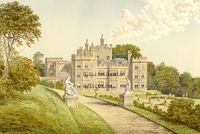Annotation:Mount Edgcomb: Difference between revisions
No edit summary |
m (Text replacement - "garamond, serif" to "sans-serif") |
||
| Line 1: | Line 1: | ||
=='''Back to [[{{BASEPAGENAME}}]]'''== | =='''Back to [[{{BASEPAGENAME}}]]'''== | ||
---- | ---- | ||
<p><font face=" | <p><font face="sans-serif" size="4"> | ||
'''MOUNT EDGCOMB.''' English, Jig. G Major. Standard tuning (fiddle). AABB. The melody is unique to London publisher Charles and Samuel Thompson's 1765 country dance collection. It also appears in George Spencer's 1831 music manuscript collection (Leeds, Yorkshire). There are Mount Edgcombs in Cornwall and Devon, but the title probably refers to Mount Edgcumbe [http://en.wikipedia.org/wiki/Mount_Edgcumbe_House] estate, near Plymouth, overlooking Plymouth Sound. It was the historic seat of the Earls of Edgcumbe, who constructed the manor in the mid-sixteenth century. | '''MOUNT EDGCOMB.''' English, Jig. G Major. Standard tuning (fiddle). AABB. The melody is unique to London publisher Charles and Samuel Thompson's 1765 country dance collection. It also appears in George Spencer's 1831 music manuscript collection (Leeds, Yorkshire). There are Mount Edgcombs in Cornwall and Devon, but the title probably refers to Mount Edgcumbe [http://en.wikipedia.org/wiki/Mount_Edgcumbe_House] estate, near Plymouth, overlooking Plymouth Sound. It was the historic seat of the Earls of Edgcumbe, who constructed the manor in the mid-sixteenth century. | ||
[[File:edgcumbe.jpg|200px|thumb|left|Mount Edgcumbe, Cornwall]] The building was destroyed in an air raid in World War II, and was reconstructed. | [[File:edgcumbe.jpg|200px|thumb|left|Mount Edgcumbe, Cornwall]] The building was destroyed in an air raid in World War II, and was reconstructed. | ||
| Line 7: | Line 7: | ||
<br> | <br> | ||
</font></p> | </font></p> | ||
<p><font face=" | <p><font face="sans-serif" size="4"> | ||
''Source for notated version'': | ''Source for notated version'': | ||
<br> | <br> | ||
<br> | <br> | ||
</font></p> | </font></p> | ||
<p><font face=" | <p><font face="sans-serif" size="4"> | ||
''Printed sources'': Thompson ('''Compleat Collection of 200 Favourite Country Dances, vol. 2'''), 1765; No. 81. | ''Printed sources'': Thompson ('''Compleat Collection of 200 Favourite Country Dances, vol. 2'''), 1765; No. 81. | ||
<br> | <br> | ||
<br> | <br> | ||
</font></p> | </font></p> | ||
<p><font face=" | <p><font face="sans-serif" size="4"> | ||
''Recorded sources'': <font color=teal></font> | ''Recorded sources'': <font color=teal></font> | ||
</font></p> | </font></p> | ||
Latest revision as of 14:25, 6 May 2019
Back to Mount Edgcomb
MOUNT EDGCOMB. English, Jig. G Major. Standard tuning (fiddle). AABB. The melody is unique to London publisher Charles and Samuel Thompson's 1765 country dance collection. It also appears in George Spencer's 1831 music manuscript collection (Leeds, Yorkshire). There are Mount Edgcombs in Cornwall and Devon, but the title probably refers to Mount Edgcumbe [1] estate, near Plymouth, overlooking Plymouth Sound. It was the historic seat of the Earls of Edgcumbe, who constructed the manor in the mid-sixteenth century.

The building was destroyed in an air raid in World War II, and was reconstructed.
Source for notated version:
Printed sources: Thompson (Compleat Collection of 200 Favourite Country Dances, vol. 2), 1765; No. 81.
Recorded sources:
